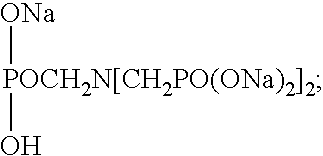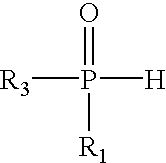Detergent compositions for the removal of complex organic or greasy soils
a technology of detergent compositions and organic or greasy soils, applied in the direction of detergent compounding agents, liquid soaps, cleaning using liquids, etc., can solve the problems of many aqueous cleaners that are simply not capable of substantial cleaning capacity, damage to the substrate, and high cost or time consumption, so as to achieve enhanced cleaning properties and less corrosive properties
- Summary
- Abstract
- Description
- Claims
- Application Information
AI Technical Summary
Benefits of technology
Problems solved by technology
Method used
Image
Examples
example 14
has been tested to be non-corrosive to aluminum and zinc metal objects or coatings, thus it is an excellent cleaner for removing all complex soils from sensitive metal surfaces or structures. The cleaners of the invention without discoloration or corrosion of metal surfaces can rapidly remove the soil comprising an inorganic solid phase and an organic phase.
example 15
is shown in these experiments to be non-corrosive to aluminum and zinc. While some impact on the metal surfaces is noted, the composition is a substantially improved soil removing agent when compared to the previous example. The material is significantly improved in the removal of soils from dirty kitchen surfaces such as a floor or window, etc. We believe the interaction between the anionic surfactant, and the other surfactants, including the silicone surfactants provide surprisingly improved soil removal of particularly particulate or clay soils. The comparisons of soil removal data for these examples demonstrate the improved properties of the invention. The compositions of the invention show high overall effectiveness as a concentrate. More surprisingly the compositions of the invention, when dissolved in an aqueous solution at a dilution rate of about 1:10 or more, forms solutions that are highly effective at soil removal. The data show that in many cases (such as Example 15) th...
PUM
| Property | Measurement | Unit |
|---|---|---|
| wt % | aaaaa | aaaaa |
| wt % | aaaaa | aaaaa |
| pH | aaaaa | aaaaa |
Abstract
Description
Claims
Application Information
 Login to View More
Login to View More - R&D
- Intellectual Property
- Life Sciences
- Materials
- Tech Scout
- Unparalleled Data Quality
- Higher Quality Content
- 60% Fewer Hallucinations
Browse by: Latest US Patents, China's latest patents, Technical Efficacy Thesaurus, Application Domain, Technology Topic, Popular Technical Reports.
© 2025 PatSnap. All rights reserved.Legal|Privacy policy|Modern Slavery Act Transparency Statement|Sitemap|About US| Contact US: help@patsnap.com



